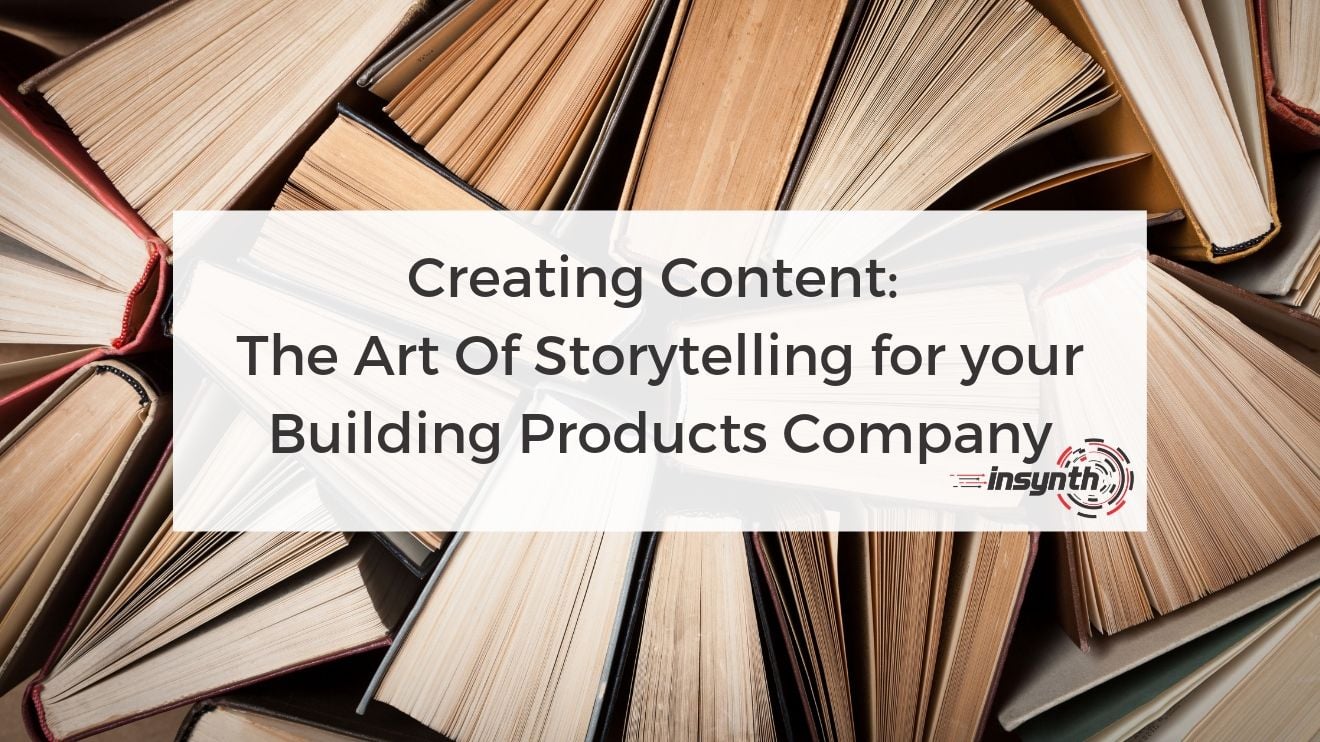5 min read
The Art Of Storytelling for your Building Products Company
![]() Rich Newsome
:
25-Jun-2019 17:29:17
Rich Newsome
:
25-Jun-2019 17:29:17


What Can You Expect From This Blog?
At this stage, you should understand what content is and how to implement a framework for content creation.
You have your blog titles and a time-frame in which to distribute them. Now, you’re tasked with actually writing the content itself.

But, how do you go about this? It’s not just a case of simply typing out what comes into your head. You may be an expert on your product, but you have to consider how this will resonate with your audience.
Will it engage your readers, or will it come across too ‘wordy’ and, thus, confuse them?
This is why storytelling plays such a big role in your content creation strategy.
In this blog, we’ll cover:
- Why your building products business needs a story
- What a story structure looks like
- Some useful tips for storytelling
- A successful example of storytelling
Why Does your Building Products Business Need A Story?
Everyone loves a good story. Stories have a unique way of influencing, inspiring and teaching readers all at the same time. Stories connect people through ideas. Stories unite people through a conviction of culture, history, and values.
The same is true in business. Telling stories is about connecting your business with your prospects and customers.

How many times have you visited a website and questioned, what is it they actually do? What do they offer? In all honesty, this happens a lot. Your building products company might be the best in the Midlands, but if your story is not clear; if your offering is not blindingly obvious, you’re likely to lose a sale.
What we’re saying is, audiences want to be spoon-fed. Content needs to be clear and obvious. Stories need to be easily accessible whilst providing educational value so that your prospects’ questions can get answered.
Stories also need to stand out.
In a world where people are on average online for 24 hours a week, there’s a need for your content to provide something different.
Structuring your Story: What Can We Learn From Little Red Riding Hood?
Regardless of the story you’re trying to tell and the message you’re trying to convey, storytelling has three main elements:
- Character(s)
- Conflict
- Resolution
You may think that this is the case for children’s stories, but the same strategy can be applied for your building products company.
- Any good story involves a character or set of characters. In your building products company, the character is the reader. Ideally, you’ll have a good understanding of your customer, whether it is an architect, contractor or individual requiring your services.
To put this into context, here is an example: An architect is looking for anti-ligature products for a mental health setting that he has been tasked with designing. He needs to know how anti-ligature products will not only provide safety and security for its service users but how they’ll fit in with the design element of his project.
He comes across a blog post that speaks directly to him, addressing his aims and objectives in a clear, accessible way. He’s not sold quite yet, so he finds another blog post from the same company. This time, the blog delves a little deeper into all the anti-ligature products available; product specification, sizing and colour options, etc.
At this stage, the architect feels as though he has found a company that speaks to his needs and requirements and he’s ready to make a purchasing decision.

Great content has the ability to appeal to a range of people at the same time. We recommend that you always aim to place the reader at the centre of your story.
- The conflict is the problem your reader faces; the whole reason they came across your article in the first place. Your primary aim here is to provide answers, relieve stress and make lives easier.
If your story does not address the conflict that the reader is facing, you run the risk of delivering a pitch or a plain statement. This won’t resonate with audiences and won’t get you views, shares, conversions or customers.
Understanding your target audiences' 'problems' is key here. A customer's 'problem' will be different depending on what stage they are at in their buying journey.
For example, an architect who is in the early design stage of a building process may just want to know what anti-ligature products are.
Once the architect has a good understanding of the product, he may then want to explore the benefits of anti-ligature products.
Following on from this, the architect might want to learn more about how to maintain such products, before exploring size and colour options.
The key message here is that your prospects will have different conflicts depending on what phase in the buying journey they are at. When developing content, we recommend that you consider the different conflicts the prospects face.
- This ties in nicely with the resolution element of your story. Where there is a problem, there has to be a solution. At this stage, you should be asking yourself ‘How did the characters change?’ and ‘What happens next?’
The resolution should wrap up your story but should also clearly call your audience to action. Think about your story's purpose. Ask yourself: has the purpose been fulfilled?
You should be providing your readers with a ‘next step’. This could be a ‘call to action’ to some additional content on your website, or even a form to fill in which allows readers to download an offer.
The revenue you’ll gain from this will be a well-structured business plan and customers who believe in what you do.
Two Top Tips To Take You Further
Whilst bearing in mind the three elements that make a good story, there are also some useful tips to keep in mind.
- Create an emotional appeal. Emotions are what make your story powerful. Always consider the emotional response you’re aiming to gain from your reader. Is it empowerment, fear, guilt, amusement, excitement or hope?
- Be clear. Always aim to keep your purpose straightforward and neat. Always ask yourself: Could I cut this story down? Could I shorten my sentences so that they are easier for the reader to digest? Often, readers are put off by sentences that are too lengthy. Make it easy for them to fully engage with your writing.
A Success Story In The Building Products Industry
In considering the industry leaders when it comes to storytelling, I urge you all to explore https://www.riverpoolsandspas.com/. Whilst navigating through the website, ask yourself:
- Are their values and goals clear?
- Are there opportunities for visitors to gain knowledge?
- Is it easy to navigate and locate the desired material?
The answer to all those questions is, of course, yes. If you’re a potential customer, the chances are you’re looking to find out how much it costs to install a pool in your garden. Straight away you’re given the option to get an instant quote.
If a customer is still at the very early stages of their decision-making process, there are ample opportunities to find out more information. There’s a ‘learning centre’ with over 700 articles and 140 videos.
River Pools and Spas are a primary example of how content creation can revolutionise your return on investment. One of their first articles entitled ‘How Much Does a Fibreglass Pool Cost?’ has generated more than three million in revenue since its release date in 2015.
There are several reasons for the article’s success, but the main reason was:
It answered a question that no-one else had answered before.
Previously, pool companies were overly cagy about the costing of pools. River Pools and Spas provided an honesty that resonated and connected with people.
They told a story.
Conclusion:
What messages should you take away from this article? The art of storytelling is quite a simple process when you strip everything back.
If you’re finding it a challenge communicating your knowledge in such a format, the chances are you’re over-complicating it. Keep things clear and concise and don’t use too many fancy or technical language.
Keep your characters, conflict, and resolution in mind and use this as an outline for your next blog.
If you’d like any tailored support with your content, whether it is mapping out a content plan, creating a framework or improving your writing skills, don’t hesitate to get in touch!
I wish you the very best of luck for your next blog (or should I say story?). Happy Writing!
About Insynth
As the only HubSpot certified agency to major on construction marketing, we bring together construction marketing strategy, digital strategy, website design, SEO, content marketing, email marketing, sales automation, marketing automation and HubSpot CRM implementation to produce successful campaigns and great results for our clients.
Book Your Free Consultation Today
